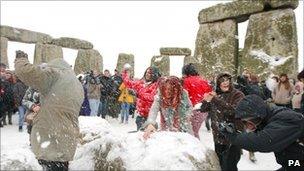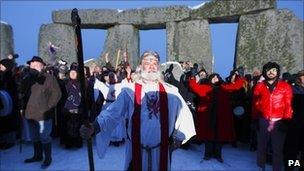Stonehenge marks winter solstice despite snow and ice
- Published
The winter morning mist obscured the actual sunrise which took place just after 0800 GMT
Snow and ice failed to stop people visiting Stonehenge to watch the sunrise on the winter solstice.
More than 2,000 people gathered at the stones which were surrounded by a thick blanket of snow.
As well as the traditional druid and pagan ceremonies, a spontaneous snowball fight erupted as people enjoyed the cold weather.

The winter solstice is the shortest day of the year
The winter morning mist obscured the actual sunrise which took place just after 0800 GMT.
Among the Druids, hippies and sun worshippers were those just curious to experience the spiritual event at the site, on Salisbury Plain, in Wiltshire.
'Peaceful atmosphere'
Serving soldier of 15 years Lance Corporal Paul Thomas, who fought in Iraq, was "knighted" with a sword by senior druid King Arthur Pendragon.
Formerly known as John Rothwell, King Arthur changed his name by deed poll.

More families are beginning to join in the celebration according to English Heritage
He also performed a handfasting - a pagan marriage ceremony - inside the stones.
The shortest day of the year often falls on December 21, but this year the druid and pagan community marked the first day of winter on 22 December because the modern calendar of 365 days a year - with an extra day every four years - does not correspond exactly to the solar year of 365.2422 days.
During the winter solstice the sun is closer to the horizon than at any other time in the year, meaning shorter days and longer nights.
Peter Carson of English Heritage said: "Despite the cold weather, over 2,000 people attended and it was a cheerful and peaceful atmosphere.
"Stonehenge looked spectacular in the snow and it was a great way for people to start their festive season."
Mr Carson said this year saw an increase in families joining the celebration as well as the number of people coming from overseas.
"The popularity of the winter solstice has grown over the years as more is known about Stonehenge and the winter solstice and the whole celebration has grown in popularity," he said.
- Published21 June 2010